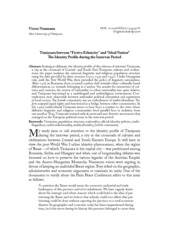Приказ основних података о документу
Timişoara between “Fictive Ethnicity” and “Ideal Nation”. The Identity Profile during the Interwar Period
| dc.creator | Neumann, Victor | |
| dc.date.accessioned | 2018-11-09T13:22:52Z | |
| dc.date.available | 2018-11-09T13:22:52Z | |
| dc.date.issued | 2013 | |
| dc.identifier.issn | 0350-7653 | |
| dc.identifier.uri | https://dais.sanu.ac.rs/123456789/4369 | |
| dc.description.abstract | Seeking to delineate the identity profile of the citizens of interwar Timişoara, a city at the crossroad of Central- and South-East-European cultures and civilizations, the paper analyzes the national, linguistic and religious population structure using the data provided by three censuses (1910, 1930 and 1941). Under Hungarian rule, until the First World War, there prevailed the policy of linguistic nationalism. After 1918, in Romania, there occurred a policy shift towards ethno-culturally based differentiation, i.e. towards belonging to a nation. Yet, amidst the interaction of cultures and customs, the notion of nationality or ethno-nationality was quite relative, and Timişoara functioned as a multilingual and multireligious environment. Contradictions were observable between nationalist political orientation and aspirations of local society. The Jewish community was an embodiment of multiculturalism. The Jews enjoyed equal rights and functioned as a bridge between other communities. In the 1930s multicultural Timişoara seems to have been a contrast to the cities where different linguistic and religious communities lived parallel lives in isolation from one another. Thus, Timişoara resisted radical, racist and anti-Semitic movements that emerged on the European political scene in the interwar period. | en |
| dc.publisher | Belgrade : Institute for Balkan Studies, Serbian Academy of Sciences and Arts | |
| dc.rights | openAccess | |
| dc.rights.uri | https://creativecommons.org/licenses/by-nc-sa/4.0/ | |
| dc.source | Balcanica | |
| dc.subject | Timişoara | en |
| dc.subject | population structure | en |
| dc.subject | nationality | en |
| dc.subject | official identity policies | en |
| dc.subject | multilingualism | en |
| dc.subject | multiconfessionality | en |
| dc.subject | multiculturality | en |
| dc.subject | Jewish community | en |
| dc.title | Timişoara between “Fictive Ethnicity” and “Ideal Nation”. The Identity Profile during the Interwar Period | en |
| dc.type | article | |
| dc.rights.license | BY-NC-SA | |
| dcterms.abstract | Неуманн, Вицтор; | |
| dc.citation.spage | 391 | |
| dc.citation.epage | 412 | |
| dc.citation.issue | XLIV | |
| dc.identifier.doi | 10.2298/BALC1344391N | |
| dc.type.version | publishedVersion | en |
| dc.identifier.fulltext | https://dais.sanu.ac.rs/bitstream/id/21320/4480.pdf | |
| dc.citation.other | (44): 391-412 | |
| dc.identifier.rcub | https://hdl.handle.net/21.15107/rcub_dais_4369 |

